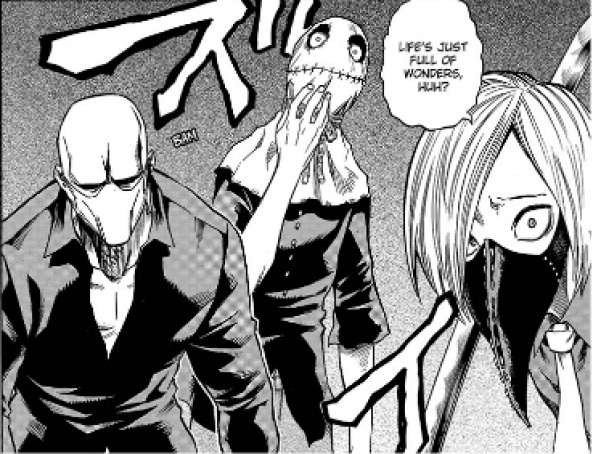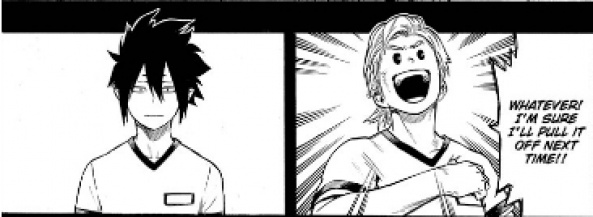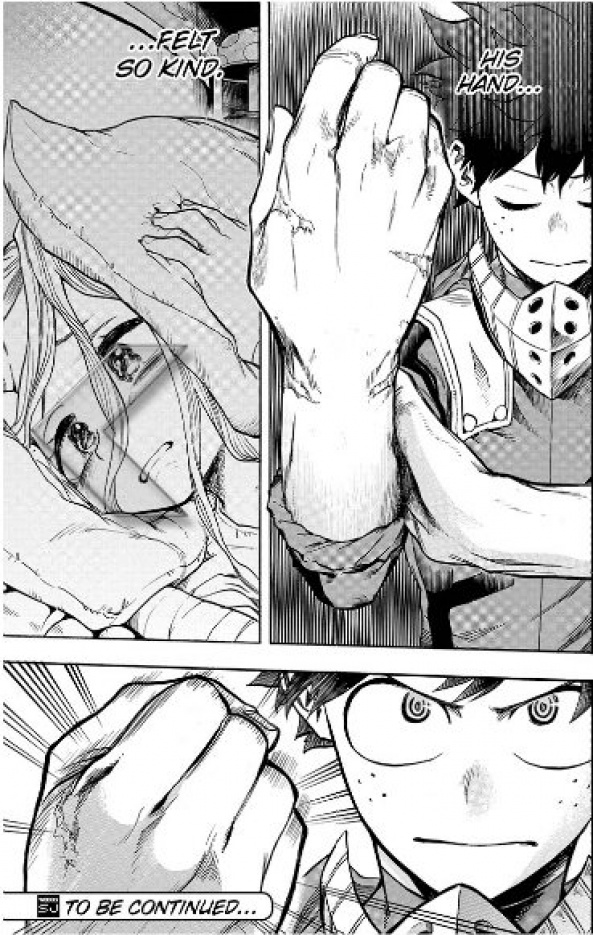In contrast to last month’s installment of ‘Go Beyond,’ where there were only three new chapters in “My Hero Academia,” the timing has been kinder this time around, gifting us five new chapters (numbered 136 through 140) to dig through.
Collectively, these chapters signal the apparent turning point in this arc, where planning and preparation evolve into swift action. While the material certainly raises new topics well worth discussing, as well as cleverly building upon previously explored themes in the series, I believe the first point worth exploring in this analysis is something many will gloss over completely: the chapter titles themselves.
When analyzing the recent chapter titles by mangaka Kōhei Horikoshi, a specific feature can be commonly found. This is the exclamation mark. It had been previously utilized only 14 times in the first 132 chapters of the series. None of these 14 usages, however, were done consecutively. This general trend was altered greatly from Chapter 133 onwards (‘Catch Up, Kirishima!’), with a whopping six out of the last eight chapters containing exclamation marks! This shift, from scarce to saturated, indicates a shift in the nature of the story.
Horikoshi’s intelligent use of punctuation is indicative of his generally masterful handling of nuanced emotional communication to his audience. These injections of excitement, achieved through the efficient and effective use of the title — a traditional narrative feature — help to relate the sense of urgency felt by the characters. This holds true for both Eijirou “Red Riot” Kirishima, during his chase and subsequent skirmish with a gun-wielding villain in Chapters 133 and 134, alongside the entirety of the group tasked with retrieving the apparent daughter of Chisaki (leader of the Shie Hassaikai), named Eri.

However, what truly elevates Horikoshi’s chapter titles to a subtle yet effective level of emotive storytelling is knowing how to use punctuation, or lack thereof. The lack of exclamation marks in chapters 135 (‘An Unpleasant Discussion’) and 140 (‘Suneater of the Big Three’), for instance, manages to highlight the urgency felt in the adjacent chapters. It is understandable for these chapters to convey a prevailing emotion other than urgency due to the former’s information-heavy briefing resulting in the arc’s objective being revealed to the reader, and the latter’s focus on a particular character’s backstory (Tamaki “Suneater” Amajiki) as he stands his ground to fight a number of villains, in turn allowing the rest of the gathered heroes and police to proceed carrying out the aforementioned objective. This level of detail demonstrates the forethought in the creative process for “My Hero Academia,” and particularly the attention to any and all small details.

Given the superhero setting of “My Hero Academia,” an element of inspiration is assuredly expected; particularly as part of any examples of the hero-civilian dynamic. After all, this concept largely conforms to the mainstream media superhero norm, wherein an altruistic individual inspires others through their own actions, as they either defeat an evil entity or save the life of someone in a dangerous situation from an unwelcome outcome. Given the world in which these characters inhabit, this rather stereotypical occurrence certainly happens. Considering the media presence that many of the series’ pro-heroes have after all, it is only sensible = these heightened individuals would inspire others to action or adoration. And yet, given his continuous penchant for multi-faceted writing, Horikoshi does not only abide by this inspirational superhero norm.
Horikoshi has never been afraid of inverting the concept of heroic inspiration completely. This kind of approach should certainly be commended, as it is bold and refreshing in the world of shōnen. Throughout “My Hero Academia,” Horikoshi has crafted numerous villains with stunning character designs, interesting motivations, and a slew of other traits that make them worth keeping around in the long-run. This much has been discussed in previous installments of ‘Go Beyond,’ especially with Tomura Shigaraki and, more recently, Chisaki (also known by his villain name, “Overhaul”). Yet with the introduction of the latest assortment of villains — who work under Chisaki and whose collective presence was referred to by Chronostasis as the “Eight Bullets of the Hassai Group” — Horikoshi has managed to implement obstacles that barely have an impact. Through the behaviour of the three Bullets we have been introduced to so far, it would appear that the entire group only exists to sacrifice themselves for the benefit of their young boss (which in this case, means buying him time so that he can escape safely with his ‘daughter,’ Eri).
Continued below
However Horikoshi does not include this simplistic but self-sacrificial mind-set for the sake of ease. Hence why on a number of occasions in Chapter 140, Setsuno’s dialogue (who appears to be the most talkative of the three Bullets) suggests a darker undertone behind their collective desire to fulfill the task handed to them by their young boss. As such, on two occasions, Setsuno actually states he and his colleagues do not care for their own lives, and, additionally, Hojo even refers to the members of the group as ‘trash.’ The most notable piece of dialogue, however, comes once again from Setsuno, as he describes a foiled suicide attempt. Rather than inspiring hope in his heart, it only inflicted greater despair. This message, that even though his body was saved in that moment but his spirit was not, is a call back to the heroic philosophy — seemingly first perpetuated by All Might’s mentor, Nana Shimura, and later by All Might himself — of not only saving a person’s life, but also saving their spirit with a smile. The failure to do exactly that is what debatably led the Bullet to eventually find a life of crime; as a means of making the most of a life he himself considered worthless. The character background and mentality of Setsuno is certainly dark and troubled. But the inclusion of such characters in the first place shows an impressive level of bravery from Horikoshi, as he looks to truly explore the full-range of repercussions that would understandably occur in a world saturated with super-humans.
While Horikoshi’s handling so far of the Bullets is overall admirable, given the short amount of time we’ve spent with them, the initial characterization and further development we’ve received for relatively new hero characters is equally as impressive. In particular, Tamaki “Suneater” Amajiki, a member of U.A. High’s Big Three. He may have received some dialogue, and as a result, some hints at a particular prior personality, but it’s only in the last two chapters or so that Suneater has begun to live up to his reputation as one of the strongest students of U.A. High. Nonetheless, once again, it is the theme of inspiration in “My Hero Academia” that has provided Suneater with some of the more prominent aspects of his backstory. Horikoshi doesn’t settle for a crude tale of inspiration like some mangaka might, instead looking to forge and display a long-standing relationship between two characters. This results in a system of two-way inspiration, driving the pair onwards and upwards, signified by their successful ascension to the lofty heights of U.A. High. This second character is the other male member of U.A. High’s Big Three: Mirio “Lemillion” Togata.

Through previous dialogue, and confirmed by the most recent flashback, it is now apparent Suneater and Lemillion have known one another since the third grade (when they were around 8 years old). As such, in terms of time elapsed, this is certainly a relationship somewhat comparable to Katsuki Bakugou and Izuku “Deku” Midoriya. Another comparison: through one reason or another, a currently active hero name was created in both of the relationships. The intent behind these names’ origins however, were vastly different. While Midoriya’s nickname was originally derisory (used by Bakugou to demean his once childhood friend), and eventually evolved into a name in which he could be proud enough to use as his hero name (thanks to some encouragement from Ochaco “Uravity” Uraraka), Suneater’s hero name was born from genuinely kind words and sentiment, relayed to him by Lemillion, when they were middle-school students. This is because although Suneater admired Lemillion’s outwardly cheery disposition and positivity (in great contrast to his own personality), Lemillion insisted the only reason he acts tough is because Suneater never backs down. No matter how nervous he may be, Lemillion works hard because he refuses to lose to his amazing friend. This solid friendship, built on a history of mutual respect and admiration for one another, typifies the well-written dynamic of two-way inspiration. Their positions as members of the Big 3 demonstrates how such a relationship can drive two friendly and talented competitors forward.

There is one final aspect that I wish to draw attention to. Toward the end of Chapter 136 (‘Close At Hand!!’), there is a brief scene with Eri. After her assigned caretaker leaves, the young girl is left alone to cry in her dark room, surrounded by a number of toys that she appears to have ignored and left in their packaging. She thinks back to her brief encounter with Deku, and rather than considering the words he said at that time, she remembers the way he looked and held her. This was with something she had never been exposed to prior to that incident: a kind hand. This insight into Eri’s thoughts is an important detail for Horikoshi to have included, as it proves Eraser Head to be right. Earlier in the chapter he reassured Deku that even though he failed to save Eri the first time, he probably gave her hope. In other words, Deku’s heroic persona, and the actions he took during his first meeting with Chisaki and Eri, inspired the young oppressed girl to believe in him, and believe that he and his kind hand will eventually rescue her from her prolonged misery.
Continued below
This use of inspiration through action and character, alongside earlier examples of inspiration through words, demonstrates the complexity of the theme Horikoshi appears to be tackling throughout “My Hero Academia.” Given the attention to detail in this regard it is clear once again Horikoshi excels at depicting the aspects of a theme that may be somewhat commonplace in a shōnen manga whilst additionally going above and beyond in making the situation both multi-faceted, and increasingly stimulating as a result.
Anyway, that’s it from me for this month. I hope you enjoyed what I had to say regarding the latest five chapters of this fantastic series, and I also hope you’ll join me next month to discuss what is sure to be another amazing batch of thought-provoking chapters in the next installment of ‘Go Beyond.’






